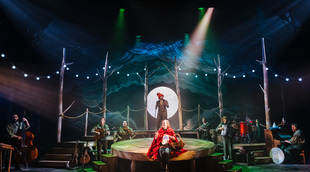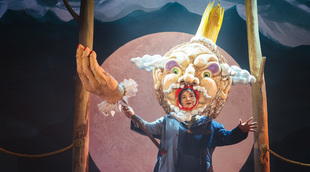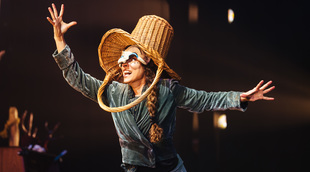 © Helen Murray
© Helen Murray
Fairy tale ‘mash-ups’, whereby many of our favourite magical stories are rolled into one, are not unknown in theatre. Stephen Sondheim’s Into the Woods constitutes one, as does arguably Act III of Tchaikovsky’s The Sleeping Beauty, in which a plethora of well loved characters dance. If, however, these works have already ensured that musical theatre and ballet are in on the act, Wolf Witch Giant Fairy now guarantees that opera is present at the party.

Wolf Witch Giant Fairy (ROH) ; © Helen Murray

Wolf Witch Giant Fairy (ROH) ; © Helen Murray
It tells the story of Little Red Riding Hood who on the way to delivering bread to her Grandmother (Jon Whitten) encounters not only the Wolf (Tom Penn), but also a host of other fairy tale characters. In this way, she finds herself having to escape from the clutches of Baba Yaga the Witch (Claire Wild), help some poor villagers whose Golden Goose (Eugénie Pastor) and Harp have been stolen, and trick the Giant (Miriam Gould) who lives in the clouds at the top of the beanstalk. All this is before she has even reached her Grandmother where further surprises await! In each instance, Red Riding Hood is ultimately victorious, though she triumphs not through brute strength but by outwitting her opponents and having the courage to stand up for what is right. It transpires that the Red family, of whom she is a part, is a rather special one, and everyone is left realising how unwise it would be to underestimate the girl with the red cape.
The hour-long opera, which is presented in the Royal Opera House’s intimate Linbury Studio, is undoubtedly designed for children, but it is so cleverly constructed that it becomes easy for adults to appreciate its intelligence and become caught up in the associated magic. The piece is presented by the Royal Opera and Little Bulb in association with Farnham Maltings, and is an ensemble affair in every sense. The three people who conceived the work also appear in it with the director Clare Beresford playing Red Riding Hood and the musical director Dominic Conway taking on the Head Villager. The ten performers who grace the stage play multiple parts in most cases, and even form the evening’s orchestra by playing every instrument that is required.
Samuel Wyer’s set sees a semi-circular gangway, trees and lights surround a raised central disc, while Joshua Pharo’s lighting designs conjure up a range of atmospheric effects. The staging is generally lo-tech, but that is deliberate as it creates a sense of wonder in its own right, while a very high level of slickness is achieved. For example, the beanstalk comes out of a hole in the disc and is made to grow by being hoisted from above. It is then pulled out of sight so that we get the impression that Red Riding Hood has climbed it and is now in the clouds, while the effect is completed with a touch of humour as we see a hand reach out to close the hole from which it rose.

Wolf Witch Giant Fairy (ROH) ; © Helen Murray

Wolf Witch Giant Fairy (ROH) ; © Helen Murray
There is a great deal of dynamism as the chorus urge the Narrator (Peter Brathwaite) to tell them what happens next, only for him to refuse and then relent. There is also a large element of humour as, for example, the Peddler (Shamira Turner) keeps changing what she sells in response to what the plot demands, and spends the entire story trying to recover the money that the Wolf owes her for a red cape he bought. There may even be some jokes that adults will find funnier than children such as when the dogs sing about how Baba Yaga never feeds them a thing. Red Riding Hood says ‘That’s terrible’ to which the Narrator responds ‘Yes, they were a bit flat’!
The music, which covers a variety of styles but seems to centre on folk, country and Eastern European sounds, is extremely catchy, and the costumes, also by Wyler, are highly inventive. For example, the villagers wear masks and hats, with the former being attached to the latter and the latter comprising upside down straw baskets. Much emotion is on display, so that when three birds arrive after Red Riding Hood realises she messed up when she traded the cow Milky White for a few beans, she really looks as if she is taking some comfort from their presence. Adults will also be able to appreciate the cleverness in reversing many roles so that the Giant is played by a woman and the Fairy by a man.
Every performance is a Relaxed Performance, meaning there is a more relaxed attitude towards noise coming from the auditorium or to people leaving it during the performance, thus making it suitable for all children. The programme also explains the necessary points so clearly that it reflects the production as a whole in rendering everything so thoughtfully, lovingly and brilliantly that, of its type, Wolf Witch Giant Fairy stands as an absolutely perfect example.
By Sam Smith
the 21 of December, 2021 | Print
Comments